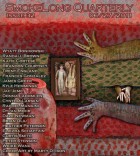One striking thing about this story is the first person plural point of view. The reader can imagine a small group of sisters or an army of women who are diminished by these “lessons.” Can you describe who you imagined the narrators to be?
I imagined the narrators as pre-pubescent girls, but I think that is the beauty of an uncertain narrator—readers can interpret the story in different ways. In my mind the girls were twins, which leaves out the element of an older girl feeling like she should be protecting a younger one. These girls experience this terrible life together, and function as more of a unit than individuals. I tried this story with a single narrator, but it was too heart-wrenching. It stripped all the hope away. There is strength in numbers, and somehow I feel like together these girls have a chance.
Women eating forbidden fruit and cutting men’s hair I recognized as Bible stories, but I didn’t recognize “women with mouths that are deep pits and drip with honey.” Is that also from the Bible?
These are also biblical references that refer to an adulterous woman, from Proverbs. I find it fascinating that the Bible was written primarily by men with an agenda, and throughout the years it has often been interpreted by people in ways that fit their own agenda. In this story, the father uses these biblical stories to enforce his negative view of women. The girls hear these same stories and realize that as women, they will someday have their own power, which is exactly what the father is so afraid of.
This has a dark fairytale feel to it. Was that your intention from the beginning?
I did not intend this. I think the fairytale feel has to do with the power of nature, that if these girls listen to nature’s secrets and find a way to reign in that power, then they have a chance at surviving. A chance to leaf out. I was also surprised at the timeless quality of this story, which seems to lend itself to fairytales. This could take place today, in a house next door, or many years ago.
The father says there is a hope of saving them, because they are not yet women, but clearly they will grow into women, no matter what he does. So how does he imagine saving them?
I don’t think the father has any hope of saving them. I think he hates women, and these girls are in imminent danger as their bodies mature. Which makes me wonder what happened to their mother. Perhaps she was adulterous, and the father had something to do with her disappearance. This is exactly the sort of thing I love about flash fiction — a writer can give just enough information to encourage the reader to think about what isn’t said. And different readers will read different things between the lines, based on their own experiences and perspectives. This is true with most fiction, but the somehow the gaps within the stories seem wider the more concise the writing is.
Do you write longer works?
I seem to write on either end of the length spectrum—novels or flash fiction. I have written a historical novel, called LOT’S DAUGHTERS, which is the story of the destruction of Sodom and what happens afterward, told from the alternating perspectives of Lot’s daughters. My next novel will be contemporary, which I plan to start in September (I have three daughters and it is always difficult to start a project in the summer). In the meantime, I’m determined to get into that middle zone and write a longer short story. We’ll see what happens!



 The core workshop of SmokeLong Fitness is all in writing, so you can take part from anywhere at anytime. We are excited about creating a supportive, consistent and structured environment for flash writers to work on their craft in a community. We are thrilled and proud to say that our workshop participants have won, placed, or been listed in every major flash competition. Community works.
The core workshop of SmokeLong Fitness is all in writing, so you can take part from anywhere at anytime. We are excited about creating a supportive, consistent and structured environment for flash writers to work on their craft in a community. We are thrilled and proud to say that our workshop participants have won, placed, or been listed in every major flash competition. Community works.